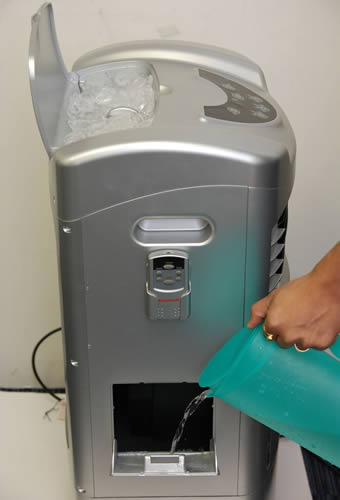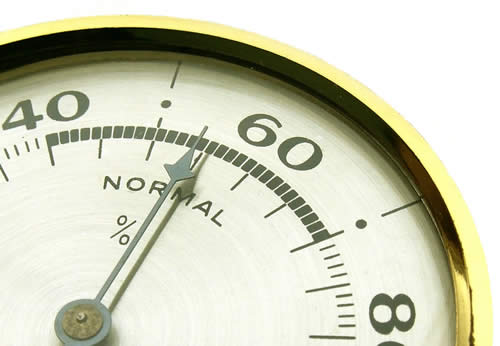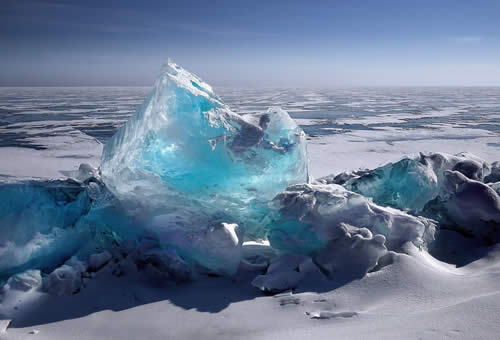- Home
- Air Conditioning
- How to Make a Swamp Cooler Colder
How to Make a Swamp Cooler Colder: 8 Tips
It is quite common to ponder over how to make a swamp cooler colder and more efficient at keeping you cool. Here are 8 tips to help you achieve better cooling from your cooler!
 While evaporative coolers (swamp coolers) are an effective and economical way to keep the temperatures down during really hot weather, there are some tricks you can use that can increase their efficiency. This can result in colder air being blasted out from them under the right circumstances.
While evaporative coolers (swamp coolers) are an effective and economical way to keep the temperatures down during really hot weather, there are some tricks you can use that can increase their efficiency. This can result in colder air being blasted out from them under the right circumstances.
While an evaporative cooler is undoubtedly an ingenious yet simple device for producing cold air, it has its limitations depending upon where you live or how you use one. So before you decide to replace an aging air conditioner with evaporative cooling equipment, I should address the major limitation before we can get on to the good stuff!
Beware Humidity
A swamp cooler's arch enemy is humidity, which in hypothetical terms is quite like kryptonite is to Superman.
When the air is very humid, its ability to absorb moisture is greatly reduced until it reaches 100% and saturation point. At that point, the air will not absorb any more moisture and the only viable alternative free standing cooler that will work is a portable air conditioner. However, that's not where I'm going with this article.
What has this got to do with a swamp cooler?
These devices create cold air by evaporating moisture and passing air through that moisture. The moisture absorbs the heat from the air passed through it, reducing the temperature of the air blasted out of the device and producing that chilled air effect.
 As ever more moisture-laden air is expelled by the cooler, the air in the room absorbs the moisture, increasing its humidity level.
As ever more moisture-laden air is expelled by the cooler, the air in the room absorbs the moisture, increasing its humidity level.
If nothing is done to intervene, the humidity increases until saturation point and the cooler emits less and less cold air until it becomes the same temperature as it went in.
That's a common complaint from novice swamp cooler owners who are unaware of this knowledge, who simply believe the device has stopped working or must be defective.
Unfortunately, the unit is not defective. The atmosphere it is being used in has become (or already is) too humid for it to work.
No that you know this (thanks to reading what I just wrote), you can take steps to alleviate the problem to a greater or lesser extent. Here are some tips you can make use of:
Eight Great Tips for Colder Air
1. Dry Climate
This ties in with the explanation given above. If you live in a dry climate, such as in the South Western region if the United States, you won't have any problems (unless you live close to a large body of water, such as the ocean, lake or large river).
Check with the local weather station to get the humidity level for the day if you have any doubts. If it is higher than around 50%, expect your cooler to be less effective the higher that number is.
2. Open a Window
In many instances, the humidity outside can be lower than it gets inside when you are running a swamp cooler in an enclosed space. If there is no circulation of air in the room you want to cool down, the air will reach saturation point fairly quickly and negate the cooling effect of the cooler.
One of the best ways to overcome this problem is to simply crack open a window or two to create a cross draft. That will cycle the moisture-laden air out of the room and replace it with drier air from outside, allowing the cooler to work the way it's supposed to.
3. Use a Dehumidifier
In an enclosed space where it is not practical to open a window (or the outside humidity is also high), a clever trick is to run a dehumidifier to mop up the excess moisture pumped into the air by the cooler. Bear in mind that a dehumidifier also uses electricity and will reduce the economy angle of using a swamp cooler somewhat.
It might just make sense to check the energy consumption figures for a suitably powerful dehumidifier plus the evaporative cooler running together and see if their combined usage is anywhere close to that of a reasonably powered portable air conditioner.
If you find that you are still saving a good amount of energy by using an evaporative cooler and dehumidifier combination, then go with that solution. The positioning of the dehumidifier can make a difference to how efficient the cooler is at producing cold air.
Placing the dehumidifier close to the cooler's rear intake grill will provide the cooler with the driest air to flow across its absorption pads for the highest level of evaporation
If, on the other hand there is not much difference in energy usage, it would make sense to use an air conditioner to keep cool. The point is that an air conditioner will cool you much more effectively than a swamp cooler when the air is humid.
4. Moisture Absorbing Plants
An alternative to using a dehumidifier and saving on energy costs is to place certain varieties of household plants that absorb moisture from the air around the room. There are several plant species of desert-dwelling plants that have evolved naturally to get their moisture from the air rather than from the parched soil.
Here are some suggestions:
Bromeliads; Cacti; Aloe; Yucca; Succulents; Peace Lily; Euphorbia; Boston fern; Air plants.
5. Prime the Pads
All swamp coolers have an absorbent medium (cooling pads) that they pass air through to create the evaporation of moisture. Before you get cold air coming out of the unit, those pads need to be fully wet.
You can achieve this by first priming them with water. Simply put, first get them wet!
With most coolers, that simply means fill the water tank and allow a little time for the pads to soak up the water before turning the unit on. Remember that as the pads soak up water at foist, they will lower the tank's water level, which you can top up before turning on.
6. Location, Location, Location
Most smaller portable swamp coolers are designed for cooling a single room or spot cooling. You can check the unit's specifications to see how many square feet it is rated for as well as the air flow rating in CFM (Cubic Feet per Minute).
It is helpful to have the unit blowing air directly at you to get the best cooling effect.
It is also a good idea to place the unit close to (and with its back or air intake vent to) a cracked open window. This will enable it to intake drier air from outside and circulate the air in the room better.
7. Cold Water, Not Ice
 There have been physical studies done by manufacturers to ascertain the best water temperature to generate the coldest air flowing from the cooler.
There have been physical studies done by manufacturers to ascertain the best water temperature to generate the coldest air flowing from the cooler.
The general consensus from the results obtained suggest that 50°F is the optimum water temperature.
You might think that adding ice to the water will make colder air, but that is actually not necessarily the case. Icy water will give an initial blast of cold air, but that will soon normalize as the evaporation process gets underway.
8. Maintenance
Swamp coolers are just like many other appliances in that they perform best when regularly cleaned and maintained in good order. A periodic inspection throughout the hot season is necessary to reveal potential problems in the making and to keep the unit working as efficiently as possible.
Here are some suggestions:
- Clean the air intake grill, fan and air outlet area with a vacuum cleaner
- Inspect the cooling pads for cracks or signs of mold or mildew, replacing if necessary
- Wash out the reservoir with mild soapy water (remembering to rinse thoroughly afterwards)
- Wipe down the unit's exterior after use
Before you pack the unit away for the cold season, make sure it is completely dry, especially the cooling pads. This is to prevent the formation of mold build-up while it is in storage.
A surprising number of instances of poor performance in producing cold air can be linked to lack of maintenance and unwillingness to keep the unit clean and the vents free of dust and debris build-up. Keep your cooler clean and well maintained it will perform much better for you, while in many cases providing you with colder air than a neglected one will!
[BACK TO TOP]
Posted on Wed, May 22 2019 in Air Conditioning | 2 Comments
Previous Post: Self Evaporating Portable Air Conditioner: 4 Reasons to Want One
2 thoughts on "How to Make a Swamp Cooler Colder: 8 Tips"
Cook says:
June 29, 2019
Thanks for clarifying that point John. It can be more cost-effective to run a dehumidifier and swamp cooler together rather than a portable AC as long as the dehumidifier doesn't use too much electricity. I see in your case it certainly doesn't!
John says:
June 27, 2019
I might be able to help clear up point about using a dehumidifier and the cost involved. I run a Honeywell swamp cooler (200 watts) with a Frigidaire dehumidifier (530 watts) together with pretty good results. The Frigidaire model is FAD504DWD Energy Star compliant. I get good cold air blasting out of the cooler even though it's pretty humid where I am (60-70% most days/nights). The total wattage used by both units is around 730 watts - much, much better compared to a 1-2kW portable AC. Thanks!